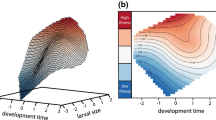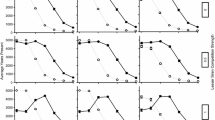Abstract
Life-history theory suggests that optimal timing of metamorphosis should depend on growth conditions and time constraints under which individuals develop. Current models cannot make reliable predictions for species in ephemeral habitats where individuals often face an increasing mortality risk over time because these models assume time-invariant mortality rates (i.e., daily mortality rates remain constant) and fixed seasons. We examined the plasticity of growth, development, and body mass at metamorphosis in tadpoles of the tree-hole breeding frog Phrynobatrachus guineensis in relation to an unpredictable time constraint in the field and in controlled experiments along a fixed density and food gradient. Mean mass and age at metamorphosis of sibships were positively correlated with per capita food level. Based on our results, we developed a simple model of the optimal timing of metamorphosis under time-dependent mortality rates showing that development rates are not only adjusted to growth conditions but also to time-variant mortality rates. The increasing mortality rate represents a time constraint that favors a reduced larval period, but because it is based on probabilities of survival it allows a trade-off between development time and mass. We extend this model to different types of time constraints and show that it can predict the range of documented reaction norms. Differences between species in␣the correlation of age and mass at metamorphosis may have evolved due to differences in their time-variant mortality rates.
Similar content being viewed by others
References
Abrams PA, Leimar O, Nylin S, Wiklund C (1996) The effect of flexible growth rates on optimal sizes and development times in a seasonal environment. Am Nat 147:381–395
Alford RA, Harris RN (1988) Effects of larval growth history on anuran metamorphosis. Am Nat 131:91–106
Altwegg R, Reyer H-U (2003) Patterns of natural selection on size at metamorphosis in water frogs. Evolution 57:872–882
Beiswinger RE (1975) Structure and function in aggregation of tadpoles of the American toad, Bufo americanus. Herpetologica 31:222–233
Berrigan D, Charnov EL (1994) Reaction norms for age and size at maturity in response to temperature – a puzzle for life historians. Oikos 70:474–478
Berrigan D, Koella JC (1994) The evolution of reaction norms – simple-models for age and size at maturity J Evol Biol 7:549–566
Berven KA (1981) Mate choice in the wood frog Rana sylvatica. Evolution 35:707–722
Berven KA (1990) Factors affecting population fluctuations in larval and adult stages of the wood frog (Rana sylvatica). Ecology 71:1599–1608
Berven KA, Gill DE (1983) Interpreting geographic variation in life-history traits. Am Zool 23:85–97
Blakley N (1981) Life-history significance of size-triggered metamorphosis in milkweed bugs (Oncopeltus). Ecology 62:57–64
Bradshaw WE, Johnson K (1995) Initiation of metamorphosis in the pitcher-plant mosquito – effects of larval growth history. Ecology 76:2055–2065
Day T, Rowe L (2002) Developmental thresholds and the evolution of reaction norms for age and size at life-history transition. Am Nat 159:338–350
Denver RJ, Mirhadi N, Phillips M (1998) Adaptive plasticity in amphibian metamorphosis: response of Scaphiopus hammondii tadpoles to habitat desiccation. Ecology 79:1859–1872
Esch GW (1977) Regulation of parasite populations. Academic Press, New York
Gosner KL (1960) A simplified table for staging anuran embryos and larvae with notes on identification. Herpetologica 16:183–190
Gotthard K, Nylin S (1995) Adaptive plasticity and plasticity as an adaptation: a selective review of plasticity in animal morphology and life history. Oikos 75:3–17
Grimko MH, Mason FS, Smith-Gill SJ (1973) Analysis of the crowding effect in Rana pipiens tadpoles. J Exp Zool 186:63–72
Hensley FR (1993) Ontogenic loss of phenotypic plasticity of age at metamorphosis in tadpoles. Ecology 74:2405–2412
Hentschel BT, Emlet RB (2000) Metamorphosis of barnacle nauplii: effects of food variability and a comparison with amphibian models. Ecology 81:3495–3508
Johansson F, Rowe L (1999) Life history and behavioral responses to time constraints in a damselfly. Ecology 80:1242–1252
Johansson F, Stoks R, Rowe L, De Block M (2001) Life history plasticity in a damselfly: effects of combined time and biotic constraints. Ecology 82:1857–1869
Joly P, Morand A, Plenet S, Grolet O (2005) Canalization of size at metamorphosis despite temperature and density variations in Pelodytes punctatus. Herpetol J 15:45–50
Jones M, Laurila A, Peuhkuri N, Piironen J, Seppa T (2003) Timing an ontogenetic niche shift: responses of emerging salmon alevins to chemical cues from predators and competitors. Oikos 102:155–163
Kozlowski J, Wiegert RG (1987) Optimal age and size at maturity in annuals and perennials with determinate growth. Evol Ecol 1:231–244
Laurila A, Kujasalo J (1999) Habitat duration, predation risk and phenotypic plasticity in common frog (Rana temporaria) tadpoles. J Anim Ecol 69:1123–1132
Leips J, Travis J (1994) Metamorphic responses to changing food levels in two species of hylid frogs. Ecology 75:1345–1356
Ludwig D, Rowe L (1990) Life-history strategies for energy gain and predator avoidance under time constraints. Am Nat 135:686–707
Lytle DA (2001) Disturbance regimes and life-history evolution. Am Nat 157:525–536
Lytle DA (2002) Flash floods and aquatic insect life-history evolution: evaluation of multiple models. Ecology 83:370–385
Moeur JE, Istock CA (1980) Ecology and evolution of the pitcher-plant mosquito. J Anim Ecol 49:775–792
Morey S, Reznick D (2000) A comparative analysis of plasticity in larval development in three species of spadefoot toads. Ecology 81:1736–1749
Morey S, Reznick D (2004) The relationship between habitat permanence and larval development in California spadefoot toads: field and laboratory comparisons of developmental plasticity. Oikos 104:172–190
Newman RA (1988) Adaptive plasticity in development of Scaphiopus couchii tadpoles in desert ponds. Evolution 42:774–783
Newman RA (1989) Developmental plasticity of Scaphiopus couchii tadpoles in an unpredictable environment. Ecology 70:1775–1787
Newman RA (1994) Effects of changing density and food levels on metamorphosis of a desert amphibian, Scaphiopus couchii. Ecology 75:1085–1096
Pfennig DW, Mabry A, Orange D (1991) Environmental causes of correlations between age and size at metamorphosis in Scaphiopus multiplicatus. Ecology 72:2240–2248
Plaistow SJ, Lapsley CT, Beckerman AP, Benton TG (2004) Age and size at maturity: sex, environmental variability and developmental thresholds. P Roy Soc Lond B 271:919–924
Reznick DN (1990) Plasticity in age and size at maturity in male guppies (Poecilia reticulata) – an experimental evaluation of alternative models of development. J Evol Biol 3:185–203
Rice WR (1988) Analyzing tables of statistical tests. Evolution 43:223–225
Rödel M-O (1998) A reproductive mode so far unknown in African ranids: Phrynobatrachus guineensis Guibé & Lamotte, 1961 breeds in tree holes. Herpetozoa 11:19–26
Rödel M-O, Rudolf VHW, Frohschammer S, Linsenmair KE (2004) Life history of a West-African tree-hole breeding frog, Phrynobatrachus guineensis Guibe and Lamotte, 1961 (Amphibia: Anura: Petropedetidae). In: Lethinen RM (ed) Ecology and evolution of phytotelm-breeding anurans. Misc. Publ. Mus. Zool. Univ Mich., Ann Arbor, pp 31–44
Roff DA (1980) Optimizing development time in a seasonal environment – the ups and downs of clinal variation. Oecologia 45:202–208
Rowe L, Ludwig D (1991) Size and timing of metamorphosis in complex life cycles: time constraints and variation. Ecology 72:413–427
Rudolf VHW, Rödel M-O (2005) Oviposition site selection in a complex and variable environment: the role of habitat quality and conspecific cues. Oecologia 142:316–325
Scott DE (1994) The effect of larval density on adult demographic traits in Ambystoma opacum. Ecology 75:1383–1396
Semlitsch RD, Caldwell JP (1982) Effects of density on growth, metamorphosis, and survivorship in tadpoles of Scaphiopus holbrooki. Ecology 63:905–911
Semlitsch RD, Scott DE, Pechmann JHK (1988) Time and size at metamorphosis related to adult fitness in Ambystoma talpoideum. Ecology 69:184–192
Skelly DK, Werner EE (1990) Behavioral and life-historical responses of larval American toads to an odonate predator. Ecology 71:2313–2322
Smith DC (1983) Factors controlling tadpole populations of the chorus frog (Pseudacris triseriata) on Isle Royale, Michigan. Ecology 64:501–510
Smith DC (1987) Adult recruitment in chorus frogs: effects of size and date at metamorphosis. Ecology 68:344–350
Smith-Gill SJ, Berven KA (1979) Predicting amphibian metamorphosis. Am Nat 113:563–585
Smith-Gill SJ, Gill DE (1978) Curvilinearities in the competition equations: an experiment with ranid tadpoles. Am Nat 112:557–570
Sokal RR, Rohlf JF (1994) Biometry. W.H. Freeman & Company, New York
Stearns SC (1992) The evolution of life histories. Oxford Univ. Press, Oxford, UK
Stearns SC, Koella JC (1986) The evolution of phenotypic plasticity in life-history traits – predictions of reaction norms for age and size at maturity. Evolution 40:893–913
Steinwascher K (1978) Interference and exploitation competition among tadpoles of Rana utricularia. Ecology 59:1039–1046
Travis J (1981) Control of larval growth variation in a population of Pseudacris triseriata (Anura: Hylidae). Evolution 35:423–432
Travis J (1984) Anuran size at metamorphosis: experimental test of a model based on intraspecific competition. Ecology 65:1155–1160
Twombly S (1996) Timing of metamorphosis in a freshwater crustacean: comparison with anuran models. Ecology 77:1855–1866
Via S, Lande R (1985) Genotype-environment interaction and the evolution of phenotypic plasticity. Evolution 39:505–522
Werner EE (1986) Amphibian metamorphosis – growth-rate, predation risk, and the optimal size at transformation. Am Nat 128:319–341
Werner EE (1988) Size, scaling and the evolution of complex life cycles. In: Ebenman B, Persson L (eds) Size-structured populations. Springer, New York, pp 60–81
Werner EE, Gilliam JF (1984) The ontogenetic niche and species interactions in size structured populations. Annu Rev Ecol Syst 15:393–425
Wilbur HM (1976) Density-dependent aspects of metamorphosis in Ambystoma and Rana sylvatica. Am Nat 57:1289–1296
Wilbur HM (1977) Propagule size, number, and dispersion patterns in Ambystoma and Rana sylvatica. Am Nat 111:43–68
Wilbur HM (1980) Complex life-cycles. Annu Rev Ecol Syst 11:67–93
Wilbur HM (1987) Regulation of structure in complex-systems – experimental temporary pond communities. Ecology 68:1437–1452
Wilbur HM, Collins JP (1973) Ecological aspects of amphibian metamorphosis. Science 182: 1305–1314
Acknowledgments
We thank H. M. Wilbur, A. E. Dunham, E. Strohm and two anonymous reviewers for providing valuable comments on earlier drafts of the manuscript. This publication is part of the BIOLOG-program of the German Ministry of Education and Science (BMBF; Project W08 BIOTA-West, 01 LC0017). Lodging facilities in TNP were provided by the Centre de Recherche en Ecologie. The Station de Recherche en Ecologie Tropical (SRET) and the Taï Monkey Project (TMP) provided logistic support. Research permission was given by the Ministère de l’Enseignement Supérieur et de la Recherche Scientifique, of the Republic of Ivory Coast. The access permit to TNP was issued by the Ministère de la Construction et de l’Environnement.
Author information
Authors and Affiliations
Corresponding author
Rights and permissions
About this article
Cite this article
Rudolf, V.H.W., Rödel, MO. Phenotypic plasticity and optimal timing of metamorphosis under uncertain time constraints. Evol Ecol 21, 121–142 (2007). https://doi.org/10.1007/s10682-006-0017-9
Received:
Accepted:
Published:
Issue Date:
DOI: https://doi.org/10.1007/s10682-006-0017-9




